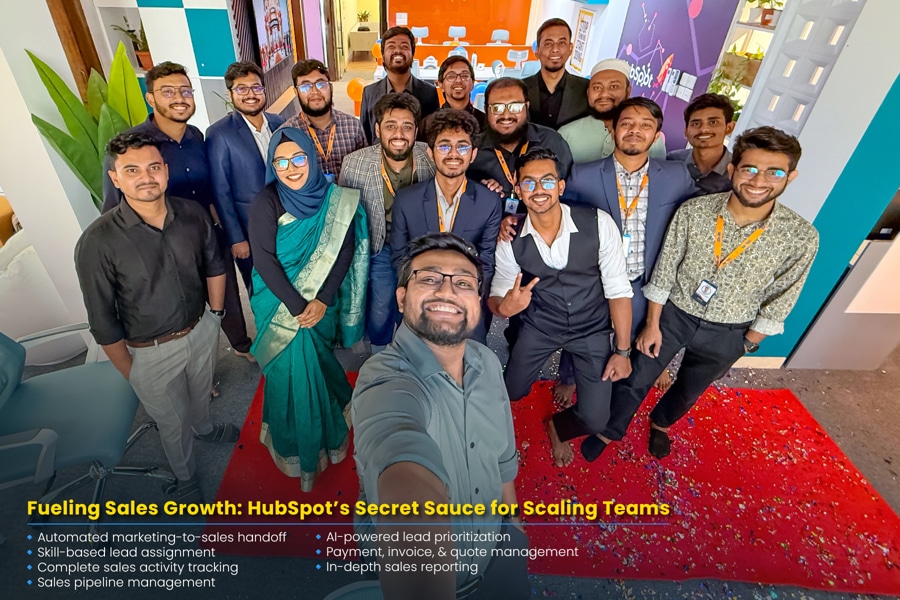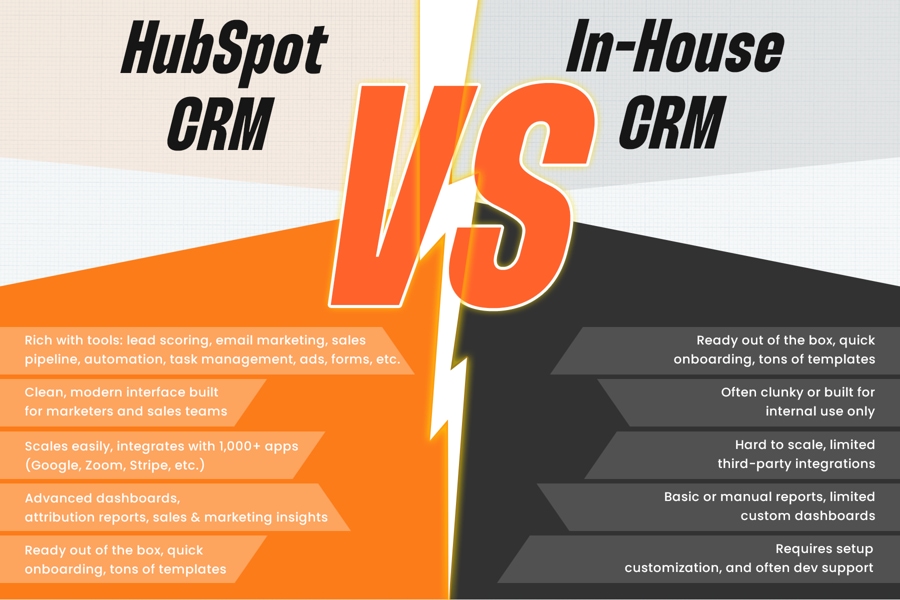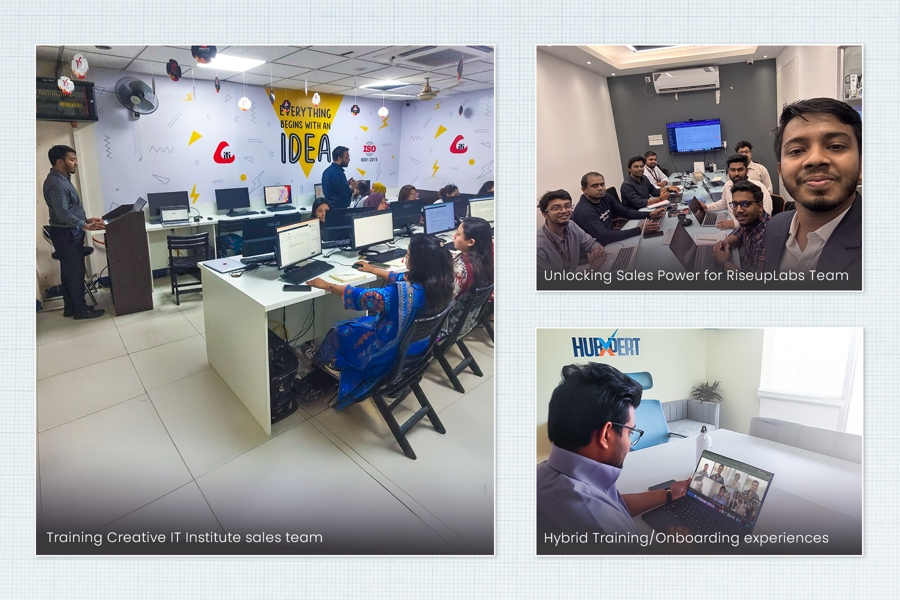
In today's hyper-competitive business environment, the difference between stagnation and exponential growth often comes down to a single factor: operational efficiency. Among the greatest enemies of this efficiency is fragmented data management—disconnected information systems and operational silos that impede decision-making and obscure valuable insights.
For high-growth companies and startups, this challenge intensifies as they raise capital and pursue rapid scale, efficiently and effectively managing operations becomes the most critical challenge.
What begins as a manageable inefficiency quickly becomes an existential threat to sustainable growth.
As companies expand, the complexity of managing customer relationships, marketing efforts, and sales processes multiplies exponentially.
This is precisely where a sophisticated and properly implemented Customer Relationship Management (CRM) system becomes transformational. Acting as the central nervous system of a growing business, a well-implemented CRM like HubSpot serves as the connective tissue between ambitious growth targets and actual performance.
By consolidating all business data in one place—from marketing channels, social media channels, email marketing, and sales activities to customer interactions and operational metrics—into a single, accessible platform, an intelligent CRM eliminates the need for disparate spreadsheets and labor-intensive data merging. Decision-makers gain real-time visibility across all operations, with clear data lineage that tracks information to its source.
While CRM adoption is well-established in many mature markets, emerging economies like Bangladesh are just beginning to recognize its potential. The startup ecosystem, in particular, stands to gain tremendous advantages from the early implementation of these systems.
In this article, we explore why CRM implementation can be a critical inflection point for growing companies and provide a strategic framework for approaching this transformation.
To prepare this piece, we draw from conversations with industry experts, including Fazle Rabbi, Senior HubSpot and RevOps Strategist and COO at Hubxpert, a HubSpot Platinum Partner serving both international and local Bangladeshi companies. Their experience and insights reveal not just the theoretical benefits of smart CRMs but the practical, revenue-generating realities of proper implementation.
In a compact glass-walled office overlooking the streets of Dhaka, a team of engineers at a local tech startup huddles around a screen, analyzing colorful charts that track customer interactions across multiple platforms.
Just six months ago, this data lived in dozens of spreadsheets. Today, it flows automatically into a centralized dashboard.
At the center of this change is HubSpot, a comprehensive marketing and sales platform, and local implementation partners like Hubxpert that help companies navigate the complex transition.
"Before implementing HubSpot, our marketing and sales teams were essentially operating as separate islands," said a founder of a Dhaka-based educational technology company who requested anonymity to discuss internal operations. "We were spending significant resources on advertising but couldn't accurately track which channels were actually driving conversions."
This experience is common.
One of the major problems that plagues most growing companies as they move from experimentation to growth-focused operations: fragmentation of business data and processes.
A typical growth-stage company in Bangladesh (or anywhere, really) operates with a patchwork of systems that rarely talk to each other.
Without a unified CRM system, critical business information becomes scattered across disparate tools: marketing leads tracked in one spreadsheet, sales follow-ups in another, customer service inquiries in email threads, and analytics reports generating contradictory conclusions. And management struggles to get a unified view of business performance.
"The main difficulties companies face without a CRM are around tracking the customer journey—from where they started, where they ended, and their behaviours along the way," explains Fazle Rabbi, COO of Hubxpert. "When your data lives in different places, you're essentially flying blind."
This fragmentation creates several critical failure points:
1. Inaccurate Marketing Attribution
When you're running ads across Facebook, LinkedIn, Google, and other platforms, determining which channel truly deserves credit for a conversion becomes nearly impossible without proper tracking.
As Rabbi notes: "Someone saw a LinkedIn ad first that day, they saw Facebook second, Facebook shouldn't get the credit, LinkedIn should get the credit. This decision, if they don't have a CRM, they won't know."
When companies can't accurately determine which channels generate true conversions, budget allocation becomes inefficient guesswork—companies continue pouring money into channels that seem to perform well on paper but aren't driving bottom-line results.
2. The Lost Lead Problem
The handoff between marketing and sales departments becomes a costly chasm where valuable leads frequently disappear.
Without a structured system: "Many sales are lost in the handoff process," Rabbi points out. "Someone contacted them today, but when they call back after a month, there's no history of the previous interaction. The sales team ends up repeating information, the customer gets bored, and conversion rates decrease."
When sales representatives lack context from previous interactions, they're forced to repeat information in subsequent calls, creating a frustrating experience for potential customers. The result? Lower conversion rates and missed opportunities.
3. Priority Blindness
Without intelligent lead scoring and prioritization, sales teams often default to chronological outreach – a costly mistake when dealing with high-value opportunities.
Consider this scenario shared by Rabbi: "If a builders company arranged an event and got 1000 leads. Among these 1000 leads, there might be 10 potential customers who will buy a house or a plot within this month or this week. If the team members of the company call them in sequence without prioritizing, and if they call that interested person after 10 days, then they would have already lost that lead."
In fast-moving markets, timing is everything. Delays in reaching high-potential leads directly result in lost revenue.
4. Personalization Challenges
Finally, personalization suffers. When you don’t have details about your customers or systems in place to personalize messaging. Customers receiving generic communications are less likely to engage than those receiving targeted outreach based on their specific interactions with the company.

The solution to these problems isn't simply purchasing CRM software—it's implementing a comprehensive, integrated system that connects marketing, sales, and customer service while providing actionable intelligence.
This is where Hubspot comes in.
Let's examine how a properly implemented HubSpot ecosystem addresses the above-mentioned challenges by centralizing marketing, sales, and customer service activities in a single ecosystem.
Unified Data Architecture: The fundamental advantage of a smart CRM like HubSpot is the creation of a single source of truth for all customer interactions.
Rather than juggling multiple platforms, companies can track all customer interactions in one place. This creates a comprehensive view of each prospect's journey, from initial awareness to conversion and beyond:
This unified architecture eliminates data silos and provides complete visibility into the customer journey, from first awareness to post-purchase support.
Marketing Attribution: HubSpot's attribution modeling allows companies to understand the full customer journey rather than just the last touchpoint before conversion.
With proper attribution, companies can allocate marketing budgets based on actual performance, identify which channels initiate customer relationships vs. which close deals, and optimize the entire marketing funnel rather than just focusing on conversion points.
The financial impact is significant—marketing efficiency improves dramatically when investments follow actual results rather than misleading platform metrics.
More importantly, Hubspot allows companies to connect all marketing channels—Facebook, LinkedIn, Google, email campaigns, SMS, and more—to track performance holistically.
Personalization at Scale: The data captured in a CRM enables personalization far beyond adding a customer's name to an email. It enables personalized marketing at scale, with automated workflows sending targeted messages based on specific customer behaviors.
If someone visits a product page on your landing page but didn't buy, you can send them a message like, 'You visited this product yesterday or at this time. Will you buy it now? Here's a 10% discount for you.'"
This behavior-based personalization extends across channels – from email to WhatsApp to SMS – creating cohesive, contextual communication that significantly improves conversion rates.
Optimize Content Strategy with HubSpot’s Blog Management: Most companies publish blogs, but can’t track their impact. One often overlooked but critical feature of HubSpot is its integrated blog management system, which streamlines content creation, publishing, and performance analysis—all within the CRM.
Marketing Automation: HubSpot’s marketing automation capabilities are a game-changer for companies looking to scale without sacrificing personalization or speed. It allows automated responses to customer actions. For example, if a visitor abandons a cart, an instant email/SMS offers a 10% discount.
Similarly, HubSpot automates campaigns across email, WhatsApp, and SMS within a single workflow. On top of it, syncing HubSpot with Facebook/Google Ads allows you to retarget users who visited specific pages (e.g., pricing) but didn’t convert.
Intelligent Lead Management: HubSpot transforms the sales process through automated lead routing, process reinforcement, and prioritization.
Leads are automatically assigned to the most appropriate team member based on expertise, availability, or other criteria. Consistent follow-up is ensured through structured workflows. High-value opportunities are prioritized through intelligent scoring, which means that when leads flood in, HubSpot automatically prioritizes outreach based on customizable criteria.
For example, a B2B startup receiving 1,000 inquiries could instantly identify and contact the 10 most likely buyers before competitors reach them.
This systematic approach eliminates human error in the sales process while ensuring that the most promising opportunities receive immediate attention.
Sales Automation: Leads are automatically routed to the right rep based on criteria like service type (e.g., “website design” leads go to the design team, location, etc. on the pipeline, leads move to the next stage when they take action (e.g., “Demo Scheduled” after a calendar booking). If a lead doesn’t respond to an email in 48 hours, auto-send a WhatsApp reminder. HubSpot’s AI scores leads based on engagement (e.g., time spent on pricing pages, email opens). High-score leads rise to the top of a rep’s queue.
Bridging Marketing and Sales: When a lead converts (e.g., submits a form), HubSpot instantly creates a sales task (“Call this lead within 1 hour”) and shares the lead’s full history (ads clicked, blogs read) with the sales team, creating a seamless handoff. Similarly, post-sale automation allows auto-send invoices, feedback surveys, or renewal reminders.
Pipeline Management: Visual sales pipelines help teams track prospects through each stage of the sales process, ensuring consistent follow-up and reducing the likelihood of promising opportunities being forgotten.
Performance Analytics: Beyond tracking individual prospects, HubSpot generates team performance metrics, helping managers identify coaching opportunities and systemic bottlenecks.
Payment/Invoice/Quote Management System: HubSpot has invoice, quote, and payment management features within the platform that save both time and effort while further improving overall efficiency and management.
Advanced Analytics and Reporting: HubSpot’s advanced analytics and reporting provide In-depth marketing and sales insights and enable tracking of ROI per channel, team performance, and customer lifecycle journeys.

The theoretical benefits of smart CRM implementation are compelling, but what about measurable results?
According to Rabbi from Hubxpert's experience with over 100 companies, properly implemented HubSpot systems deliver several quantifiable improvements. Let’s take a look:
Team Efficiency: The first measurable benefit is typically operational—tasks that once required 10 team members working full days can often be accomplished by five people working half days once workflows are optimized.
"If 10 team members spent the whole day solving issues, now with our system, those 10 team members don't need the whole day,” claimed Rabbi. “Five team members can do the work in half a day."
This efficiency gain translates directly to lower operational costs and the ability to scale without proportional headcount increases.
Conversion Rate Improvements: With proper lead prioritization, personalized follow-up, and structured sales processes, companies typically see significant improvements in conversion rates at every stage of the funnel:
Reduced Customer Acquisition Cost: The combination of marketing attribution optimization and sales efficiency directly reduces customer acquisition costs, often one of the most significant constraints on startup growth.
Improved Customer Retention: By maintaining a complete interaction history and enabling proactive customer service, smart CRM implementation also positively impacts retention metrics and lifetime customer value.
Revenue Growth: Ultimately, improved efficiency and conversion should drive top-line growth—the final and most important metric of success.
Cultural Transformation: Perhaps the most profound impact of proper CRM implementation isn't technological but cultural. When executed correctly, these systems fundamentally change how businesses operate.
Decisions shift from intuition-based to data-driven. Departments begin working with shared information and aligned goals. And companies anticipate customer needs rather than simply responding to requests
This cultural transformation often produces the most sustainable competitive advantages, as technology can be replicated more easily than organizational capabilities.

Here's where we encounter a crucial insight: the difference between HubSpot as a software product and HubSpot as a transformative business system lies in implementation strategy.
Many companies purchase CRM software but fail to see results because of the implementation gap. They often lack a clear implementation plan aligned with business objectives. Fail to properly train team members. Don't customize the system to match their specific workflows. And can't effectively interpret and act on the data collected
This implementation gap explains why partnerships with specialized agencies like Hubxpert often deliver significantly better outcomes than in-house attempts.
For cash-conscious startups, the obvious question is, why not handle implementation internally? Why pay a partner when the information needed to configure HubSpot is theoretically available online?
The answer comes down to specialized expertise. Effective implementation often requires multiple skill sets: marketing expertise, sales process design, technical development, and change management.
While some companies attempt to hire dedicated HubSpot specialists, these individuals rarely possess the comprehensive expertise that comes from implementing the platform across dozens of different businesses.
Implementation partners bring pattern recognition—they've seen what works and what doesn't across numerous clients. Experienced implementation partner provides cross-functional expertise, proven methodologies, and battle-tested implementation frameworks rather than learning through trial and error.
Additionally, agencies like Hubxpert come with training capabilities to ensure team adoption through structured education and ongoing optimization by continuously refining the system based on performance data.
The investment in expert implementation often pays for itself through accelerated time-to-value and avoidance of costly mistakes.

We have talked about how the implementation gap can limit return on investment when it comes to CRM.
Despite many excellent capabilities and tangible benefits, many startups struggle to implement HubSpot effectively. The platform's sophistication, while ultimately beneficial, creates a steep learning curve for teams accustomed to simpler tools.
We take a look at Hubxpert's methodology to gain valuable insights into effective CRM implementation:
1. Discovery and Goal Setting: The implementation process typically begins with understanding a company's existing workflows. Consultants examine how data is currently managed, what sales processes are in place, and what obstacles are preventing growth. This diagnostic phase is followed by system design, where experts configure HubSpot to address the specific challenges identified.
"One of our consultants first has a meeting with the client, like a kickoff call if you will”, explained Rabbi. “In the first kickoff call, we try to understand how they are currently managing their system, we understand their current process. After understanding that, then we want to know about their goals, what they want in the future."
This foundation ensures that the technical implementation serves business objectives rather than creating technology for its own sake.
2. System Design: Rather than simply configuring software, effective implementation involves designing comprehensive workflows that match the company's specific needs. "We have an internal meeting, and in the meeting, we explain a system to them that, if implemented for their business, will lead to their growth, will solve the issues they are currently facing, and how we can ensure their growth," Rabbi explained.
3. Phased Implementation: Instead of overwhelming teams with a complete system change, the most successful implementations follow a phased approach: "We gradually bring them into the system, create reports for management."
This incremental adoption increases the likelihood of user acceptance while delivering early wins to build momentum.
4. Training and Support: Training is particularly critical in markets like Bangladesh, where teams may be transitioning directly from spreadsheets to sophisticated automation. Without proper education, even the most powerful CRM becomes an expensive, underutilized tool
"Training is essential, especially locally. If we can't train the team properly, the system won't work", said Rabbi.
5. Continuous Optimization: Implementation isn't a one-time event but an ongoing process of refinement based on performance data:
"We create team efficiency and create a comparison with the previous week. Gradually, when they work in the first week, their efficiency will be a bit low; in the next week, it will increase."
Learning from Hubxpert's experience with hundreds of implementations, several common mistakes emerge:
1. Premature Abandonment: CRM systems require sufficient time to accumulate data and for teams to adapt to new workflows. Companies that abandon implementation too quickly never realize the potential benefits. "If we are working with a system,” explained Rabbi, “say our marketing and sales system, and after one month we give up thinking results are not coming, it takes time."
2. Inadequate Training: When team members don't fully understand the system or its benefits, they often revert to old habits and workarounds, undermining the entire implementation.
3. Failing to Understand Reports: Data without interpretation doesn't drive action. Companies must develop the analytical capabilities to translate CRM insights into business decisions. "One report can have several meanings,” said Rabbi. “So, it's important to understand these reports, either from the management level or from the HubSpot consultant or CRM expert."
For companies considering smart CRM implementation, the following checklist provides a starting framework:
As we've seen throughout this analysis, smart CRM implementation has evolved from a competitive advantage to a competitive necessity for growing companies.
The fragmentation problem—disconnected data, inefficient processes, and missed opportunities—creates an increasingly insurmountable barrier to scaling as competition intensifies and customer expectations rise.
Properly implemented systems like HubSpot, guided by experienced partners, don't just solve technical challenges; they enable the organizational transformation required for sustainable growth.
Companies that have secured funding and are focused on rapid scaling find that proper CRM implementation allows them to grow revenue faster than headcount, a critical factor in achieving positive unit economics.
In particular, for Bangladesh's growing cohort of funded startups in education technology, software services, and B2B sectors that are focused on rapid scaling, proper CRM implementation can help grow their revenue faster than headcount, a critical factor in achieving positive unit economics.
Rabbi summarized: "If we can implement all the features of these two processes of Hubspot, marketing and sales, well for a company, their growth will rapidly increase."
In the end, the decision isn't whether to implement a smart CRM system but rather how quickly and effectively you can do so before competitors gain an unassailable advantage in efficiency, customer experience, and data-driven decision-making.
